Auxiliary battery: Difference between revisions
(language) |
No edit summary |
||
| Line 4: | Line 4: | ||
== Battery == | == Battery == | ||
For auxiliary battery it is better to not use a starter battery (e.g. most automotive batteries), | For an auxiliary battery it is better to not use a starter battery (e.g. most automotive batteries), | ||
but a [https://en.wikipedia.org/wiki/Deep_cycle_battery deep-cycle] battery that is designed to be regularly deeply discharged using most of its capacity. | but a [https://en.wikipedia.org/wiki/Deep_cycle_battery deep-cycle] battery that is designed to be regularly deeply discharged using most of its capacity. | ||
| Line 21: | Line 21: | ||
== Installation == | == Installation == | ||
Battery fits tight in the left side of the trunk. For better fit wrap around it solid rubber sheets. | Battery fits tight in the left side of the trunk. For a better fit, wrap around it some solid rubber sheets. | ||
To put back the electronics bracket, it has to be cut below the navigation device level. | To put back the electronics bracket, it has to be cut below the navigation device level. | ||
[[MOST Audio Gateway|Audio gateway]] which was below the [[MOST Navigation|navigation unit]] can be attached to the navigation unit with cable ties as shown in the picture. | [[MOST Audio Gateway|Audio gateway]] which was below the [[MOST Navigation|navigation unit]] can be attached to the navigation unit with cable ties as shown in the picture. | ||
If [[MOST CD Changer|CD Changer]] is used, the space for it has to be found somewhere else. | If [[MOST CD Changer|CD Changer]] is used, the space for it has to be found somewhere else. | ||
Since the lower part of electronics bracket is cut off, the bracket now is attached only by 2 screws instead of 3. | Since the lower part of electronics bracket is cut off, the bracket now is attached only by 2 screws instead of 3. | ||
However, the installation is pretty tight anyway and unless the W220 is thrown on its roof the battery will not move | However, the installation is pretty tight anyway and unless the W220 is thrown on its roof the battery will not move from its place. | ||
Note that since the left side of the trunk is not square, two outer corners of the the battery will deform a bit | Note that since the left side of the trunk is not square, | ||
two outer corners of the the battery will deform the chassis a bit (as can be seen in the picture below). | |||
{| | {| | ||
| Line 37: | Line 38: | ||
== Charging == | == Charging == | ||
We want the auxiliary battery to be isolated from the main circuit when the car is off (to not drain the auxiliary battery and vice versa), | We want the auxiliary battery to be isolated from the main circuit when the car is off (to not drain the auxiliary battery and vice versa), | ||
while connecting to the main circuit when the car is running so that alternator would charge both - the starter battery and the auxiliary battery. | |||
To do this automatically the starter battery's positive terminal and auxiliary battery's positive terminals must be connected together (using wires at least 3mm in thickness) by high current (200A) relay (EUR 10). The negative terminal of auxiliary battery can be permanently attached to the chassis. | To do this automatically, the starter battery's positive terminal and auxiliary battery's positive terminals must be connected together (using wires at least 3mm in thickness) by high current (200A) relay (EUR 10). The negative terminal of auxiliary battery can be permanently attached to the chassis. | ||
The relay should be activated by positive 12-volt wire from alternator's D+ terminal (warning lamp wire). | The relay should be activated by positive 12-volt wire from alternator's D+ terminal (warning lamp wire). | ||
This will make sure that auxiliary battery is connected to the main circuit only when the alternator is already producing the output. | This will make sure that auxiliary battery is connected to the main circuit only when the alternator is already producing the output. | ||
The optimal place to install the relay is to put it under the rear seat and attach it to the electronics bracket. | The optimal place to install the relay is to put it under the rear seat and attach it to the electronics bracket. | ||
The wire from engine bay can be passed to right footwell through the right fuse box and then to the rear seat | The wire from engine bay can be passed to right footwell through the right fuse box and then to the rear seat (consult [[Rear view camera#Wiring|rear view camera wiring]] guide). | ||
{| | {| | ||
Revision as of 18:55, 17 February 2016
This page shows how to install auxiliary battery and connect it to the charging system. Auxiliary battery is useful to power a coolbox/fridge or set up a 24/7 surveillance system without worrying about the starter battery being drained while the engine is not running.
Battery
For an auxiliary battery it is better to not use a starter battery (e.g. most automotive batteries), but a deep-cycle battery that is designed to be regularly deeply discharged using most of its capacity.
Crown 27DC115 (EUR 200) is battery that perfectly fits in the left side of W220 trunk.
Specification:
|
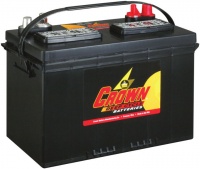 |
Installation
Battery fits tight in the left side of the trunk. For a better fit, wrap around it some solid rubber sheets. To put back the electronics bracket, it has to be cut below the navigation device level. Audio gateway which was below the navigation unit can be attached to the navigation unit with cable ties as shown in the picture. If CD Changer is used, the space for it has to be found somewhere else. Since the lower part of electronics bracket is cut off, the bracket now is attached only by 2 screws instead of 3. However, the installation is pretty tight anyway and unless the W220 is thrown on its roof the battery will not move from its place. Note that since the left side of the trunk is not square, two outer corners of the the battery will deform the chassis a bit (as can be seen in the picture below).
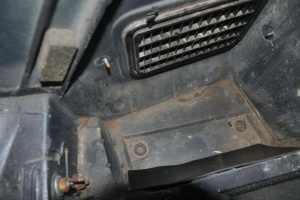 |
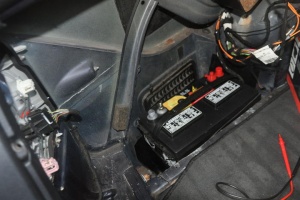 |
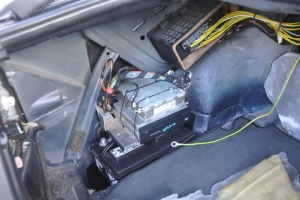 |
Charging
We want the auxiliary battery to be isolated from the main circuit when the car is off (to not drain the auxiliary battery and vice versa), while connecting to the main circuit when the car is running so that alternator would charge both - the starter battery and the auxiliary battery. To do this automatically, the starter battery's positive terminal and auxiliary battery's positive terminals must be connected together (using wires at least 3mm in thickness) by high current (200A) relay (EUR 10). The negative terminal of auxiliary battery can be permanently attached to the chassis. The relay should be activated by positive 12-volt wire from alternator's D+ terminal (warning lamp wire). This will make sure that auxiliary battery is connected to the main circuit only when the alternator is already producing the output. The optimal place to install the relay is to put it under the rear seat and attach it to the electronics bracket. The wire from engine bay can be passed to right footwell through the right fuse box and then to the rear seat (consult rear view camera wiring guide).
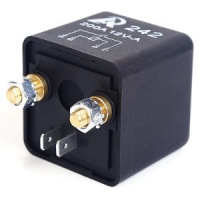 |
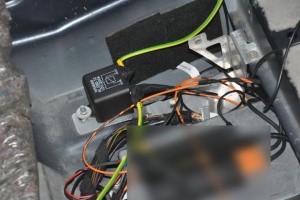 |
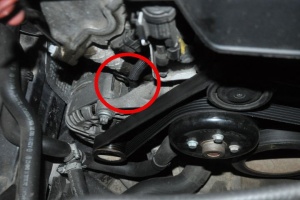 |
Original Auxiliary Battery
A second battery fitted on the right-hand side of the trunk above the existing battery is an optional extra in Europe. It is clearly shown in WIS/ASRA under AN54.10-P-00021 and requires a new battery holder, circuit breaker and new modified trunk paneling for the right-hand side.